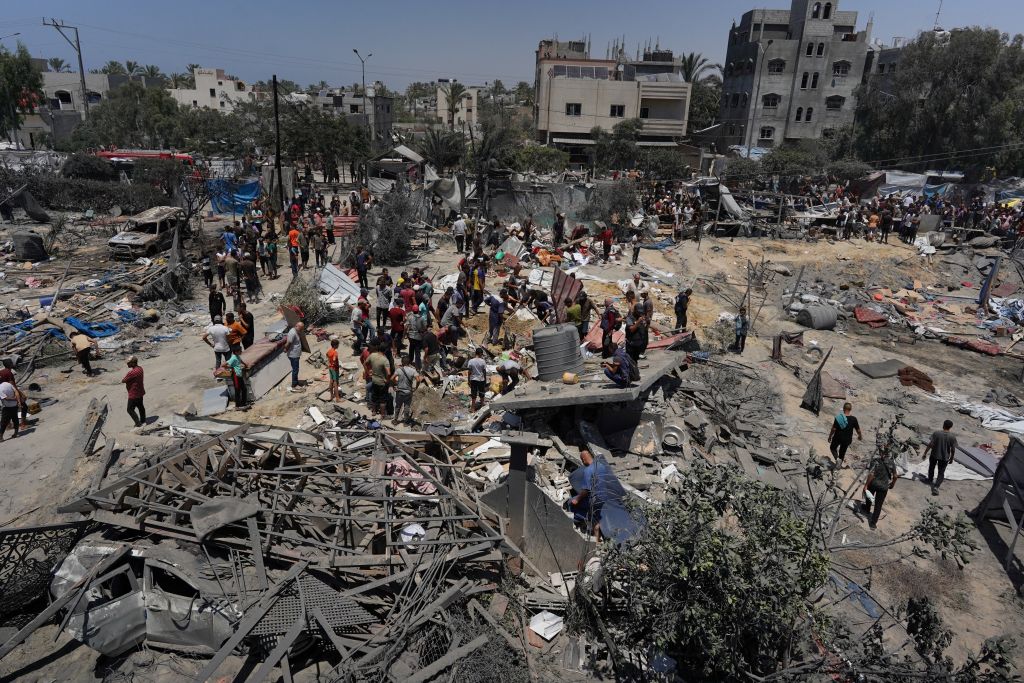This piece was originally published in a different form on 16 July.
If the Pimpernel was damned and elusive, he had nothing on Mohammed ‘the guest’ al-Masri, the head of Hamas’s military wing. The ‘guest’ moniker – ‘Deif’ in Arabic – was gained by decades of moving from house to house nightly to avoid assassination. Despite reportedly losing an eye and a leg in attacks, he continued to evade the missiles as if charmed. The 58-year-old shadow was by far the longest-surviving senior leader of Hamas.
This morning, one day after the sensational assassination of Ismail Haniyeh in Tehran, the IDF has finally confirmed his death. On 10.29 a.m. on Saturday 13 July, the skies above al-Mawasi, a safe zone west of Khan Younis, opened with the eighth assassination attempt, a significant barrage of JDAMs and at least one GBU ‘bunker buster’, just in case Deif slipped into a tunnel. For the Israelis, this was an opportunity that could not be squandered. Deif’s longtime comrade, Yahya Sinwar, had cheated death at least once during this war due to an abundance of caution regarding the size of munition; with the conflict dragging on, no such chances could be taken again.
The significance of Deif’s demise cannnot be overstated. To his followers, the head of the Ezzedeen al-Qassam Brigades, the military wing of Hamas, was a talismanic folk legend. Intifadists chant about being his ‘children’ or his ‘men’, or holler slogans like, ‘with souls and blood, we redeem you, Deif’. For 30 years, while Sinwar – also now believed to be hiding around Khan Younis – spent times of quiet openly delivering speeches and visiting mosques, Deif remained a ghost, mystique clouding around him.
For years, the number of photographs of the man could be counted on a single hand. In one, he was masked. In another, released on 7 October to accompany a rare audio message from the militant, he was seen in silhouette. A third was taken many decades ago. To these were added, in recent months, a selection of others, unearthed by Israeli intelligence among millions of computer files seized in Gaza. One of these showed Deif and his close comrade, Rafa Salama, the commander of the Khan Younis Brigade, in the garden of the villa in which the two men were targeted on Saturday.
Of all the embodiments of evil in the ranks of jihadism, Deif stands at the forefront. Born around 1965 to a humble family in Khan Younis, his native cunning allowed him to graduate with a degree in the sciences from the Islamic University in Gaza, a well-known jihadi redoubt. There he reportedly chaired the entertainment society, even treading the boards himself.
As the first Intifada raged in the 1980s, Deif joined Hamas. Towards the end of the decade, he was arrested by Israel and served 16 months in prison. After his release, his rise through the ranks was rapid. In 2002, after Salah Shehadeh, founder of the Qassam Brigades, met his maker by way of a one-tonne bomb dropped by an F-16 in the al-Daraj neighbourhood of Gaza City, Deif rose to replace him. He was now one of a handful of men at the very top of Hamas. There was a target on his back.
Anybody doubting Israel’s use of assassination as a weapon of war should consider that in that corner of the Middle East, it is a weapon of survival. Deif was the guiding spirit behind the apparatus of death that claimed the lives of so many Israelis, buried hopes of peace and brought catastrophe upon the heads of Palestinians. During the 1990s, he led a wave of terror aimed at derailing the peace process. He was a skilled bomb-maker, and was behind the wave of suicide attacks that killed 65 Israeli civilians in 1996. Two years before, he had led the kidnap and murder of the young conscript Nachshon Wachsman.
All of Hamas’s achievements in transforming itself from a rag-tag jihadi militia into a well-trained, fanatical infantry army were masterminded largely by Deif. He set up the terror infrastructure in the West Bank, oversaw the construction of the 300-mile military tunnel network in Gaza and spearheaded both the suicide bomb and rocket programmes, playing a role in designing the terror group’s signature Qassam projectile.
In August 2014, Deif masterminded the abduction and murder of three Israeli teenagers, sparking a bitter, seven-week war in Gaza codenamed Operation Protective Edge. As hostilities raged, Israeli forces went for a moonshot, bombing a house in Gaza where Deif was thought to be staying. Once again, he escaped with his life, though according to Hamas, his wife and two children lost theirs. This episode only added to the mythology surrounding the jihadi killer.
A living Deif means continued war for the region, and many, many more deaths
It seems that Deif was not deterred by the tragedy. When hostilities abated, he and Sinwar wrote a joint letter to the Iranian commander Qasem Soleimani. The Hamas chiefs apologised for losing the war, placing the blame on their political leadership, which had prevented a pre-emptive attack. We won’t make the same mistake again, they promised.
Soleimani is now dead, killed in 2020 by an American drone strike ordered by Donald Trump. But Deif didn’t forget this vow. With the tunnel network expanding under Gaza, its arsenal of rockets growing and its military machinery developing, he withdrew further to become even more reclusive. In 2016, Sinwar became head of Hamas in the Strip, effectively removing the constraints of any political leadership. There was trouble ahead.
On the Israeli side, Benjamin Netanyahu developed a strategy of containment known as ‘the concept’. This suggested that economic support for Gaza, combined with an impregnable fence and superior firepower, would defang the terror threat, allowing Israelis to live in peace. Tens of thousands of Gazans were allowed into Israel to work. Aside from the occasional aerial skirmish with Hamas, Netanyahu, it seemed, had finally won peace without war.
In May 2021, another scratchy audio recording of Deif’s voice was released on Telegram. The reclusive leader could be heard delivering a ‘clear, final warning’ that if Israel continued with planned evictions in East Jerusalem, Hamas would not ‘stand by helplessly’ and the Jewish state would pay a ‘heavy price’. The property dispute was unresolved, the evictions went ahead, and the Qassams began to fly.
The conflict that ensued, which claimed hundreds of lives and brought hundreds of thousands onto the streets of London in protests – including convoys threatening through megaphones to rape Jewish women in north London – was seen in Jerusalem as such a skirmish, not a harbinger of worse violence to come. After all, no Israeli troops had entered the Strip. In retrospect, this feels unbearably complacent.
And so we come to the depravity of 7 October, launched once again with an audio message from the shadowy leader. This time, the tone was markedly different. Against a picture of the 58-year-old jihadi in silhouette, Deif could be heart calmly announcing: ‘If you have a gun, get it out. This is the time to use it. Get out with trucks, cars, axes. Today, the best and most honourable history starts.’ The butchers who led the charge, breaching the fence and falling upon families of Israeli peaceniks in a frenzy of murder, rape and mutilation, were trained by Deif. But this was an attempt to rouse a mass pogrom. It was the beginning of the end.
That end – for Deif, at least – arrived on Saturday 13 July. A contact of mine in Gaza remarked recently that ‘half of Hamas are about to be killed and the other half are now working for the Israelis’. According to Saudi sources, a mole within Deif’s inner circle tipped off Jerusalem that he was planning to emerge from the tunnels for a rare meeting with Salama above ground to discuss preparations in Khan Younis for another IDF onslaught. The information – an espionage coup equal to that leading to the rescue of Noa Argamani and three other hostages last month – was supported by signals intelligence. At last, here was Israel’s chance.
Uncharacteristically, the Saudi source claimed, Deif had been lulled into a false sense of security, believing that hostage negotiations had blunted Israel’s aggression and complacent due to the number of civilians in the area. If true, this misjudgement may have done for him. At 10.29 a.m. local time, an Israeli bomb hit part of the building in which the two men were believed to be meeting, followed quickly by a second that destroyed it entirely. The area was contained by an IDF barrage to prevent escape and a bunker buster was used to destroy any nearby tunnel openings. This was believed to be the largest quantity of munitions ever used by Israel in an assassination attempt.
Without its military mastermind, Hamas will be deprived of its operational coherence, hastening the demise of the group. It will also suffer a grave blow to morale. Of all its senior leaders, only those in charge of Rafah and Gaza city remain alive, as well as Yahya Sinwar and his younger brother, Mohammed. None of them have anywhere near the charisma, talent or experience to fill such voluminous shoes.
Psychological profiles of Sinwar suggest that he dug in his heels under pressure, so this heavy loss is unlikely to make a hostage deal more likely. A Hamas retaliation has also not transpired; for propaganda reasons, the group is desperately trying to maintain the idea that Deif lives on, so a response would undermine that messaging. But the most far-reaching consequence of his death is the repair of Israel’s intelligence and military reputations.
In the West, many have come to assume that the best way to save lives is by using as little violence as possible. But that is only because our own memories of an existential war have faded and we have not yet faced the full force of a true jihadi enemy.
In the Middle East, particularly for Israel, deterrence means harmony. It encourages alliances with moderate Arab states, who only want strength on their side. It makes the likes of Hezbollah and Iran think twice, avoiding open warfare. The media commentary has focused upon the numbers of civilians who were killed in the hit on Deif. According to Hamas, the strike killed at least 90 people. But by Deif’s hatred, his murderous life and his use of human shields, he brought it on their heads himself. A living Deif means endless death for the region. The tragedy of the conflict is such that his bloody end is the only way to pursue an elusive peace.






Comments